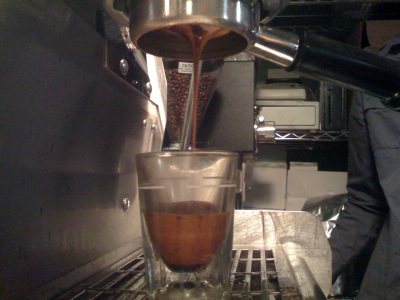So today Richard and I took coffee lessons (Espresso Fundamentals) at Joe. It was a quick class on how to pull the perfect espresso shot. I'm hoping my morning lattes will now get a lot better.
In addition to learning how to make a great shot, I learned a fair bit about espresso. For instance, there's no such thing as an 'espresso bean': espresso is a blend of many different types of beans. Joe uses a blend from the Barrington Coffee Roasting Company - who won't way what's in the blend, but the Joe baristas suspect a mix of Ethiopian and Guatemalan. FYI, this should also tip you off that when you buy a cafe's 'coffee', you're really just buying repackaged stuff from a roaster.
But I digress. We also learned that you could use single origin coffee in an espresso machine, but you wouldn't want to as the taste would be weird. It would be either too sour or too bitter - and a good espresso shot should start sour and end bitter.
Before I tell you how to do that, here's a shot (pun intended) of the machine we worked on:

So how do you create that shot? Do the following:
- Adjust the grinder to the fineness you desire
- Grind the beans into the filter. The amount should be heaping and overflowing the filter. Note that the depth of your filter will determine whether it is a single/double/triple shot
- Tap the filter against the fork of the grinder (where you were resting it as you were grinding) two or three times in order to make it settle
- Run your finger across the top of the filter to flatten the coffee: to the left, to the right, then down, then up. This ensures that there's a consistency to the coffee and that water will not 'channel' through it. If the water channels you will end up with some coffee in your shot; some plain water -all bad
- Tamp the coffee down into a puck. Do it once with 10 pounds of force and once with 30 pounds of force. This is a critical step. If you do too much the espresso will 'fall' too fast; too much and it will take too long for the water to get through your coffee puck and the flavour will be too bitter
- Run the steam/water without yet putting in the filter. This clears out any particulate
- Add the filter and then turn the steam half on for two seconds. This causes a thin film of water to form on top of the coffee and will ensure that when the steam is added it is all at the same temperature, thereby ensuring consistency in the coffee
- Turn on the water. After six seconds espresso should start to come through; after 22-26 seconds it should halt and you should turn off the water. If it drops earlier or later your coffee will not taste good. Adjust the grain of the grind in step 1 and repeat and you'll eventually work it out
There you go. How to pull the perfect shot. Here's a photo of Richard's as it was coming out:
 This shot was on it's way to being pretty much perfect. By the time it was finished he had almost exactly an ounce and a half of coffee/crema. Notice how the shot's pouring smoothly out the bottom of the filter (they call them naked filters as you can see the bottom) - that's a sign that there's no 'channeling' going on.
This shot was on it's way to being pretty much perfect. By the time it was finished he had almost exactly an ounce and a half of coffee/crema. Notice how the shot's pouring smoothly out the bottom of the filter (they call them naked filters as you can see the bottom) - that's a sign that there's no 'channeling' going on.
Damn fine coffee. Stop on by some time and you can see if I learned anything.